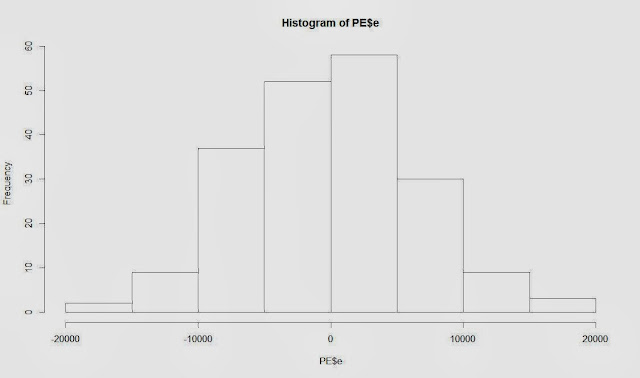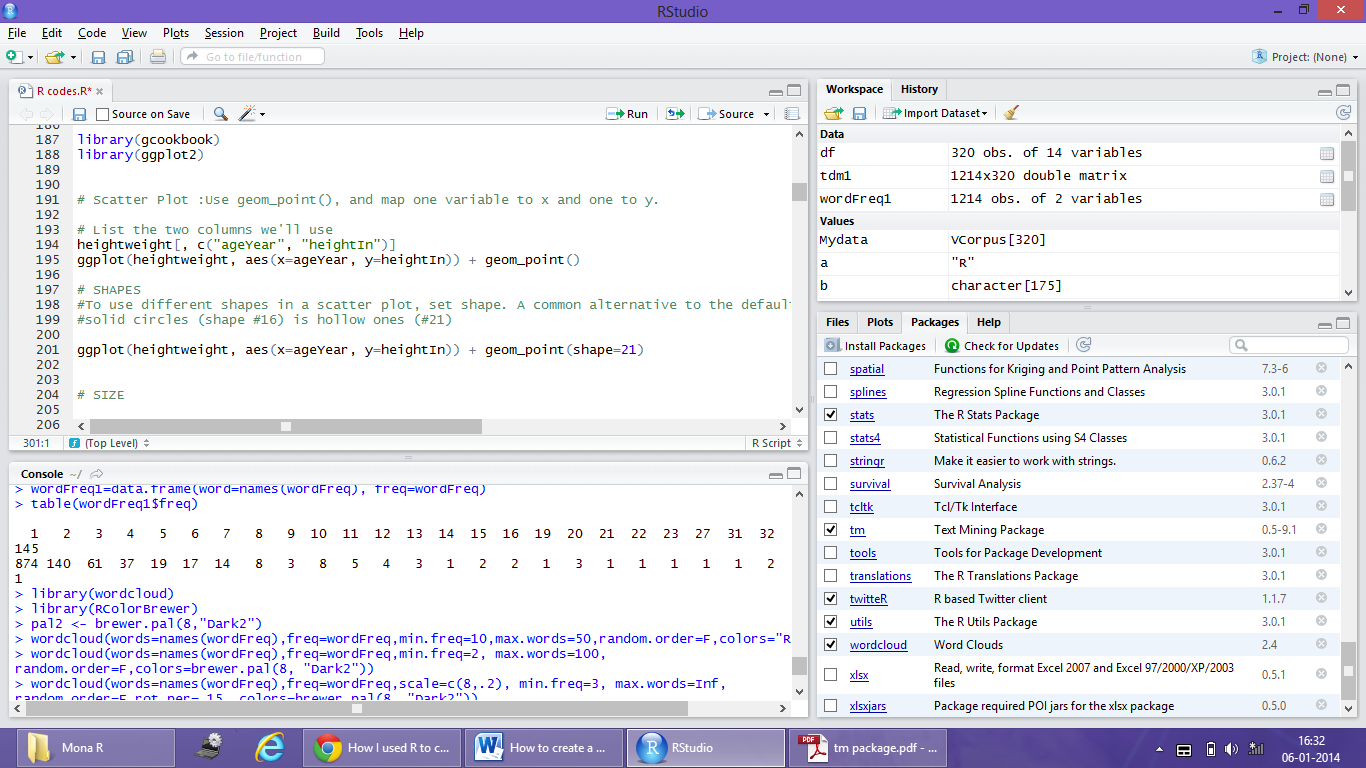Popular posts from this blog
How to create a Word Cloud in R
I have seen Word-cloud in so many places such as magazines, websites, blogs, etc. however never thought of making it by myself. I would like to thank R that taught me such a wonderful technique which everybody would like to learn. I don’t know if there are any other free options are available to create word-cloud. Let me give a quick explanation about R first, R is a free source packages and very useful for statistical analysis. We can use R for various purposes, from data mining to data visualization. Word-cloud is a tool where you can highlight the words which have been used the most in quick visualization. If you know the correct procedure and usage, then Word Cloud is simple in R Studio. Further, a package called “Word-cloud” is released in R, which will help us to create word-cloud. You can follow my simple four steps mentioned below to create word-cloud. Those are new to R or Word Cloud, I would suggest first install R studio from the link rstudio.com Also, the following...
Tour de France : History of Largest Sporting Event
Goal of the Project The goal of the project is to create an infographic-style visual to educate new viewers, highlight the magnitude of the event, and build anticipation for this year's Tour de France. This challenge requirement is different from others as here we are not getting any business insights or solution to do better. Here we have the information and we tried to spread information in easy and simple manner that more viewers can show interest in the coming years. As there are still many people has lack of knowledge about this event and access to watch this event (or lack of resources). What were business need The need is to create an infographic visual to educate new viewers about the world’s largest event Tour de France and 3.5 billion viewers were interested to watch from all around the world. My focus is to attract more viewers and provide base information or history that they don’t know. We are 8 billion population and we have to showcase this largest annual sporting ...
Maven Healthcare Challenge: Aug 2023
In recent Maven Analytics challenge, we need to do analysis of hospital survey data. The data is about National & state-level scores from 2013 to 2022 for the Hospital Consumer Assessment of Healthcare Providers and Systems (HCAHPS) survey, a national, standardized survey of hospital patients about their experiences during a recent inpatient hospital stay. First know about, what is HCAHPS? The HCAHPS survey is the first national, standardized, publicly reported survey of patients' perspectives of hospital care. HCAHPS (pronounced "H-caps"), also known as the CAHPS Hospital Survey, is a survey instrument and data collection methodology for measuring patients' perceptions of their hospital experience. HCAHPS is a patient satisfaction survey that was developed by the Agency for Healthcare Research and Quality (AHRQ) in collaboration with Centers for Medicare and Medicaid Services (CMS) beginning in 2002. It was designed to help government agencies begin to collect ...
Great thought by Mrunal Nandankar
Success is not measured by how much a man has, But how much he has done, How far he has gone. Success is the basic human knowledge, Of how well a man has done. It is not taken lightly, Or as it shouldn't be. This is a serious task. One given to man by fate. Only you can determine your success. Only people can comment it. Push your self to the limit, Gas far as you can, Strive for it, For it is important, Your success. One of the most important traits of human kind, Taken for granted by the rich, And serious by the poor. We all have it in us, What it takes to be a success. We just have to reach in deep enough, And we will soon find the success in us, That has been lying there all a long. Success is key to all of life's compances, Enjoy it while it lasts. By Mrunal Nandankar...............
Fitness Tracker Dataset Challenge
About the Project: This is a fitness tracker product dataset consisting of different products from various brands with their specifications, ratings and reviews for the Indian market. The data has been collected from e-commerce websites namely Flipkart and Amazon using web scraping technique. This dataset contains 451 samples with 16 attributes. There are some missing values in this dataset. Tool Used: Power BI
Romania New Car Registration in 2023
The Goal of the project: The goal of the project is to provide detailed analysis of new car registration market in Romania. In a single page format, you can the all the necessary details which required to know about the automobile industry. Also need to look how electric segment is doing in the market. What was business needs: The business need of the project to find the growing segment, the top car maker or model their YoY growth, the market share of different car segment etc What are your Insights: My top insights from this project are: 1.The market value is increasing significantly in 2023, which is coming to pre covid level. 2.Gasoline is top segment in car market with more than 65% market share but electric car segment is growing faster than this segment and diesel segment. 3.Dacia is top car maker in Romania and all top five selling cars are from Dacia. Dacia Logan is top selling card model but the top sales growth of the car model is Dacia Jogger. 4.Dacia is the top car se...
TOP WINE PRODUCTION AND CONSUMPTION COUNTRIES - 2022
Italy, France, and Spain were the top three producers of wine worldwide as of 2022. That year, France produced about 45.6 million hectoliters of wine. Italy was the leading producer of wine in 2022, and had the highest export volume of wine in that year, at 21.9 million hectoliters. The other two top wine producers were also the top exporters. Spain exported 21.2 million hectoliters and France, 14 million. The world vineyard surface area is estimated to be 7.3 mha in 2022, only marginally lower compared to 2021 (-0.4%). The surface area of the world vineyard seems to have stabilised since 2017. The current stabilisation, however, hides heterogeneous evolutions in the main vine growing countries. The world vineyard surface area is estimated to be 7.3 mha in 2022, only marginally lower compared to 2021 (-0.4%). The surface area of the world vineyard seems to have stabilised since 2017. The current stabilisation, however, hides heterogeneous evolutions in the main vine growing countries. ...
A Key Challenge for Apple's Quest for Carbon Neutrality
The Goal of the project: To visualize Apple progress towards becoming carbon neutral in 2030. In 2020, after announcing their corporate operations were officially carbon neutral, Apple pledged to make their products carbon neutral by 2030. To achieve this goal, they set their emissions for 2015 (38.4 million metric tons CO2e) as the baseline and will aim to reduce them by 75% by 2030. The remaining 25% of gross emissions (9.6 million metric tons CO2e) will be removed using carbon offsets, bringing the net emissions to 0. To find out the how much carbon emission is already reduced by Apple in 2022 and how it going to reduce the remaining by 2030. Key Insights: Based on the data and analysis, i have found these below points: Apple has reduced its carbon emission in corporates operations by 2020 The top three highest emission segments are manufacturing, transportations and product use How Apple will reduce the remaining emission by 2030? Apple already implementation many transformat...




.jpg)



Comments
Post a Comment